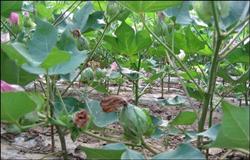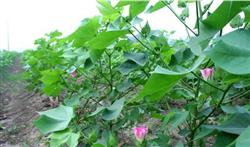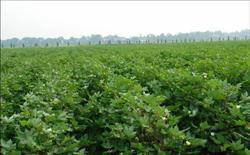Cotton planting technology: how to manage cotton flowering and boll period?

How to manage the cotton flowering and boll period? Please introduce the management methods of cotton flower and boll stage can refer to the following methods: 1. Fertilization: a large number of cotton peaches are formed in the flower and boll stage, which is the period in which cotton needs the most nutrients in its life. Re-application of flower and boll fertilizer is the key measure to protect summer peach, compete for autumn peach and prevent premature senility. The amount of topdressing should generally account for 50% or more of the total topdressing, and the time, quantity and methods of fertilization should be flexibly controlled according to factors such as climate, soil and cotton growth. If the weather is dry, base fertilizer, bud fertilizer is less, cotton plant growth is weak, boll fertilizer should be applied early and re-applied, so as to achieve "flower and boll application". If the weather is rainy, the bud fertilizer is applied more, the cotton plant is growing vigorously, and the boll fertilizer should be applied late. It is generally applied when 1-2 cotton peaches sit in the lower part of the cotton plant in full bloom, generally applying 10-13.3 kg of urea per mu, and 5-7 kg of potash fertilizer, ditching or deep application. In order to prevent cotton plants from premature senescence and multiple bolls, top fertilizer should be applied according to soil fertility and cotton plant appearance after full flowering. Generally speaking, 2.7-3.3 kg urea is applied per mu after cotton topping from the end of July to the beginning of August. If the bottom fertilizer is sufficient, soil fertilizer and cotton plants are flourishing, top fertilizer may not be applied. 2. Pruning: ⑴ smears superfluous buds. All the new buds growing at the base of the fruit branches and in the axils of the upper leaves of the fruit nodes are collectively called superfluous buds, which should be wiped with them to avoid wasting nutrients, causing shade and affecting the development of buds and bolls. ⑵ hit the top. Topping is the most important measure in the pruning technology of cotton field. Timely topping can break the top growth advantage of cotton plant, change the transport and distribution of nutrients in cotton plant, make it produce more buds and bolls, increase boll weight, and effectively control the height of cotton plant. improve ventilation and light transmission conditions, conducive to yield increase and early maturity. The time of topping is generally from late July to early August, only the top is removed, it is strictly forbidden to pull, and should be carried out in stages to make the growth of the whole field consistent. ⑶ is a bystander. The effect is similar to topping by removing the growing point of each fruit branch and controlling the lateral growth of the fruit branch. Generally, there are 2-4 fruit nodes in the lower fruit branch, 3-4 fruit nodes in the middle and 4-5 fruit nodes in the upper part. When the fruit branch reaches the planned fruit section, it will be removed. 3. Irrigation and drainage: the leaf area in the flower and boll stage is the largest, which coincides with the high temperature season, and the leaf transpiration is strong, which is the period when cotton plants need the most water in their life. when drought occurs and the soil is short of water, it will cause a large number of buds and bolls to fall off and cause premature senescence. Therefore, the flower and boll period must be watered and irrigated in time in case of drought. Generally, furrow irrigation is used, and the soil moisture should be preserved by ploughing in time after each watering. In addition, if Rain Water is too much, you should pay attention to drainage to avoid bud and bell falling off. 4. Middle tillage and soil cultivation: middle ploughing combined with topdressing at flower and boll stage can reduce grass damage, enhance soil permeability and prevent premature senescence of root system. The middle ploughing should be shallow rather than deep, so as not to hurt the roots too much, affecting the root absorption of water and fertilizer, resulting in bud and boll shedding. Soil cultivation can be combined with mid-tillage, which is beneficial to irrigation, drainage and lodging prevention. 5. Chemical control: chemical control depends on the growth and appearance of cotton plants. The chemical control with prosperous growth is increased appropriately, and the chemical control times and dosage are reduced when the growth is weak. Generally, 2-3 grams of 25% zhuangsu per mu is used in the full bud stage, 10-15 kg of water is sprayed once, 6-8 g of 25% zhuangsu is used per mu in the early flowering stage, and cotton seedlings are sprayed on 20-25 kg of water. About 7 days after topping (except for the early decaying field), the tip of the upper fruit branch of cotton branch was sprayed with 25% zhuangsu 12-20g per mu and 30-40kg of water. Click to get more cotton planting technology click to get more food crop planting technology
- Prev

Cotton planting technology: how to fertilize cotton at flowering and boll stage?
How to fertilize cotton at flowering and boll stage? Please give guidance to the cotton flower and boll period can refer to the following methods of topdressing: first, fertilizer deficiency plots to increase the amount of topdressing. In the areas with more per capita cotton planting area, some villages still maintain the state of low input and output, and the cotton planting benefit is very low. Some even apply only 10-15 mu.
- Next

Cotton planting technology: how to fertilize cotton in flower and boll stage?
How to fertilize cotton in flower and boll period? Please guide the flower and boll stage is the key period for cotton to gradually change from vegetative growth to reproductive growth, and it is also the period when cotton needs the most fertilizer. For cotton in full bloom, the partial application of nitrogen fertilizer will lead to cotton flourishing and crazy because the vegetative growth is still parallel to reproductive growth.
Related
- The first cup of black tea in spring, the flavor and history of tea gardens in Kenya, Africa
- The computer can not only choose potatoes, but also grow tea rice. AI will grow winter oolong tea champion.
- It is not only the inflated tea bitten by insects, but also engraved with the four seasons tea in Beipu.
- The Oriental Beauty Tea Festival in Zhuxian County takes the stage at the weekend to experience the plus-size feast of oil tea.
- & quot; Oriental Beauty Tea & Exploration of Emei in Hsinchu, the hometown of quot;
- The new variety of strawberry "Tainong 1" dessert is the first choice with mellow aroma. Crimson gorgeous
- History of Tea in Taiwan: from Wild Inner Mountain to Export Tea Garden
- Two types of Taiwan Oriental Beauty Black Tea won the British three-Star Award for Childhood Tea Xiang Zhang Jiaqi changed from pilot to champion tea maker.
- Banana species and varieties: the planting history of Taiwan Xianren banana and dwarf banana is long, is banana disease resistant?
- Coffee planting Technology: Qianjie Coffee from Seedling to harvesting

